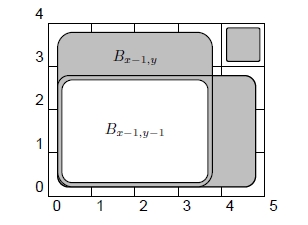At any moment during the cutting, we have a set of independent sub-problems — blocks of chocolate. If we find the optimal solution for each of the blocks, together we get the optimal solution for the whole chocolate. This clearly hints at a dynamic programming solution.
Each sub-problem we may encounter corresponds to a rectangular part of the chocolate, and it can be described by four coordinates: specifically, two  and two
and two  coordinates — the coordinates of its upper left and lower right corner. Hence we have
coordinates — the coordinates of its upper left and lower right corner. Hence we have  sub-problems to solve.
sub-problems to solve.
Now to solve a given sub-problem, we have to try all possible cuts. There are  possible cuts to try — at most
possible cuts to try — at most  horizontal and
horizontal and  vertical ones. Each possible cut gives us two new, smaller sub-problems we solve recursively. Obviously, the recursion stops as soon as we reach a
vertical ones. Each possible cut gives us two new, smaller sub-problems we solve recursively. Obviously, the recursion stops as soon as we reach a  block.
block.
Assume that someone has given us a function  that returns the number of raisins in the rectangle given by coordinates
that returns the number of raisins in the rectangle given by coordinates  and
and  in constant time.
in constant time.
Using this function we can solve the entire problem in  . We will use recursion with memoization. Given any of the
. We will use recursion with memoization. Given any of the  sub-problems, first check the memoization table to see whether we have computed it already. If yes, simply return the previously computed value. Otherwise, proceed as follows: The cost of the first cut is
sub-problems, first check the memoization table to see whether we have computed it already. If yes, simply return the previously computed value. Otherwise, proceed as follows: The cost of the first cut is  , which we have supposed can be computed in
, which we have supposed can be computed in  time. For each possible placement of the first cut, recursively determine the cost of the remaining cuts in each sub-problem, and pick the optimal choice, storing the answer in the memoization table.
time. For each possible placement of the first cut, recursively determine the cost of the remaining cuts in each sub-problem, and pick the optimal choice, storing the answer in the memoization table.

We are only missing one piece of the puzzle: the function  . All possible values can easily be precomputed in
. All possible values can easily be precomputed in  and stored in an array.
and stored in an array.
Alternatively, we can use two-dimensional prefix sums: let  be the input array, and let
be the input array, and let  . The values
. The values  are called two-dimensional prefix sums. They can be computed using the formula:
are called two-dimensional prefix sums. They can be computed using the formula:

Having the two-dimensional prefix sums, we can compute the sum in any rectangle, using a similar formula. The sum in the rectangle with corners  and
and  is:
is:


Comments